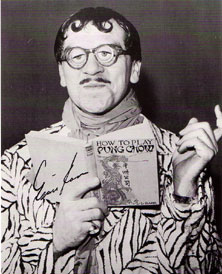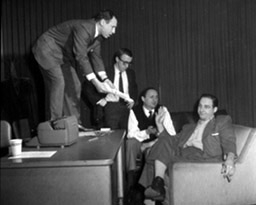AARP Eye Center
When TV Tried Something New: Ernie Kovacs and Sid Caesar
By Bill Newcott, October 25, 2012 03:28 PM
![kovacs_crookedface[1]](https://aarp-content.brightspotcdn.com/46/bc/24aa10dd45dbd23358b7303c3265/kovacs-crookedface1.jpg)
For years, I reckoned that those who longed for the so-called Golden Age of Television were really just yearning for a less complicated time, when there were two or three broadcast networks, everybody watched the same shows, and life was, well, as simple as black and white.
I've since changed my mind, especially after sampling three recent DVD sets of 1950s TV icon Ernie Kovaks and an upcoming collection of TV work by Mel Brooks.
In the '50s, TV was one big laboratory. There were, to be sure, still some old-school vaudevillians ( Milton Berle and Jimmy Durante) and transplanted playwrights (Somerset Maugham and Paddy Chayefski). Even sitcoms were nothing new: Hollywood had been making similar comedy shorts for decades.
The innovators, we've always been told, were the news guys: The very title of Edward R. Murrow's show, See it Now, proclaimed the coming of a new communication age.
But then there was Ernie Kovacs, whose body of work is well represented in three DVD sets

released by Shout! Company. Kovacs had enjoyed some success in radio, but it was on TV that he broke through in the mid 1950s. In a sense, he was the first child of television, instinctively perceiving that the electronic medium was, in fact, nothing at all like the stage or the movies. In pursuit of laughs, Kovacs tilted his camera so items on a table appeared to roll uphill. He flipped the cathode ray image upside-down. He used the TV camera's limited range to pull sleight-of-hand visual tricks that, quite simply, would never sell in a movie. He drew out his comedy bits to inconceivable lengths (How long did his Nairobi Trio go on smacking each other with mallets, anyway?) but before anyone else did, Kovacs understood that his audience, seated comfortably at home, had untapped levels of patience for a good payoff. Kovacs was to TV what Georges Melies was to the movies-he invented the language of the medium while dazzling his viewers with magical applications of innovations he was inventing on the fly.
Viewers loved Kovacs, but the TV industry never did quite figure out what to do with him. He was on the verge of starting a new career in film-where he felt he could become an auteur in the mold of Jerry Lewis or the French director Jacques Tati-when he was killed in a car crash in 1962.

Mel Brooks came to TV from the world of sketch comedy written for the stage, so he was more of a bridge between the old and new. But as Sid Caesar's personal writer, he had much to do with the creation of a new kind of comedy, a comedy that traded on the unprecedented intimacy that TV created.
I'll write more about Brooks-and a wonderful interview I did with him a couple of weeks ago-when his collection, "The Incredible Mel Brooks," is released in mid-November. The early TV icon I want to focus on here is Caesar, who kicked around as a standup comic for a brief time before, out of apparent desperation, NBC picked him to anchor a comedy show originating from New York City.
Almost immediately, it seems, Caesar and his writers-including Brooks, Neil "Odd Couple"

Simon, Larry "M*A*S*H" Gelbart, and Aaron "Andy Griffith Show" Ruben-realized that TV, with its relatively poor picture definition, was perhaps best suited for close-up comedy. A spin through old kinescoopes of Caesar's Your Show of Shows reveals one skit after another based, more or less, on the star's endless menu of facial expressions. Sometimes the joke comes from Caesar's uncanny ability to snap from one face to another. Or else he holds a single expression, seemingly forever, until the slightest shift of an eyebrow or twitch of the mouth delivers the unspoken punch line. The new Brooks set includes a skit I'd never seen before: Caesar's wife (Nanette Fabray) returns home from shopping, proudly displaying her expensive new fur coat. She natters away in the background about how much she loves it, no matter how much it cost-but Ceasear sits in the foregrouind, his face occupying virtually the entire screen. As his misery grows-and this is on live TV-a single tear rolls down his cheek. Surely, the funniest tear in TV history.
TV today has turned back the clock not to its Golden Age, but to the pre-television era altogether. The dramas, slickly produced and cinematically filmed, recall the days when Hollywood cranked out a dozen feature films a week. The comedies are either extended vaudeville sketches or direct descendants of the short film comedies of the 1930s and 40s-more risqué, perhaps, but no more sophisticated. And what are shows like Dancing with the Stars and The Voice but throwbacks to Major Bowes and his Original Amateur Hour?
In the end, it appears that real TV-TV as a unique, innovative medium-passed into the ether sometime in the early 1960s. Today it survives as a powerful entertainment delivery medium, but it is a bastard medium that, for the longest time, has not had an original idea in its pretty little head.
Photo Credits:
Ernie Kovacs: Shout!Factory
Sid Caesar Portrait: Museum of Broadcast Communications (museum.tv)
Mel Brooks and Sid Caesar: SidCaesar.com























































